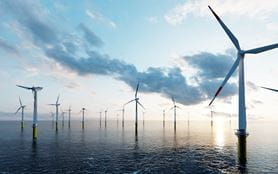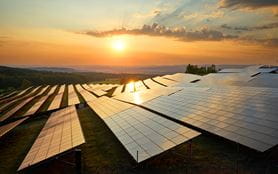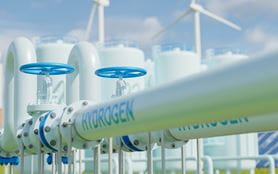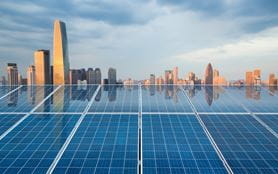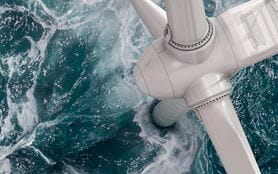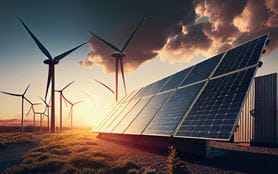Part 4: Private finance is positioned to meet the opportunity and fill the needs gap
Related people




David Lee
Partner
London

Scott Neilson
Partner
Tokyo

Matthew Townsend
Partner, Global Co-Head Environment, Climate and Regulatory Law Group and the International Trade Group
London

Anna Masser
Partner
Frankfurt am Main

Ken Rivlin
Partner, Global Co-Head Environment, Climate and Regulatory Law Group and the International Trade Group
New York

Sally Dewar
CEO, A&O Consulting
London

Gauthier van Thuyne
Partner
Brussels

Kate Sumpter
Partner
London

Bob Penn
Partner
London

George Cannon
Partner
Washington, D.C.

Goran Galic
Partner
Perth
Headlines in this article
Related news and insights
Publications: 21 March 2024
Publications: 21 March 2024
Publications: 21 March 2024
Publications: 21 March 2024
Net Zero is the biggest investment opportunity in history. But how much private money is currently being channeled towards Net Zero? And how fast is it likely to grow?
Key findings
- Corporations and commercial financial institutions together provide approximately 78% of private climate finance, more than 90% of which goes to renewables and low-carbon transport.
- Publicly announced commitments from these organizations point to future growth in climate finance, including a commitment from the 30 largest banks to finance USD870bn annually in climate solutions.
- Asset owners and asset managers have been slower to commit, with only 27% of asset owners and 2% of asset managers publicly announcing Net Zero and climate financing targets.
- VC investment in climate solutions companies reached USD70.1bn in 2022, 89% higher year-on-year, with climate-focused VC investors holding USD37bn in dry powder as of late 2022.
- However, it remains to be seen whether this growth will continue, as higher interest rates push investors to focus on near-term returns.
- Climate solutions companies have raised equity and debt capital relatively easily, though companies’ equity raising in 2022 was 40% lower than in 2021 (reflecting the general downward trend in financing).
- Similarly, in 2022 green bond issuances were 6.8% lower than in 2021. Investments in supply chain and manufacturing facilities for climate solutions increased to USD79bn in 2022, 44% higher than 2021, although annual investment needs to increase by a further 58% to stay on a Net Zero pathway.
There is a tremendous opportunity for private investors and companies to reallocate capital and take advantage of the transition to a low-carbon, resilient and just economy. In contrast, institutions that are not properly prepared for Net Zero may be stuck with stranded assets or unable to take full advantage of decarbonization-focused policy shifts.
This section analyzes current spending trends alongside future commitments to climate investment by private organizations. Specifically, we review the potential for investment by sector and by actor (based on announced commitments to future climate action), as well as analyzing broader investment trends, some of which point to potentially increased future private climate finance.
There is substantial capital being deployed that could be reallocated to climate-positive solutions. Global financial GDP estimated at USD101tn.1 While not all of that is suitable for Net Zero investment, trillions of dollars are currently being spent on sectors that will be low-carbon in the future. For example, approximately USD3.5tn is spent every year on vehicles,2 compared to the USD280bn spent on EVs in 2021.3
Subsidies for fossil fuels continue to rise
Fossil fuel subsidies hit USD1tn in 2022, a substantial rise year-on-year,4 while in the real estate sector, only USD260bn of the USD5.8tn invested in new buildings in 2021 was spent in accordance with green certificates.5 As far as adaptation and resilience is concerned, for every USD1 spent on climate-resilient infrastructure, USD87 was spent on non-climate-resilient infrastructure.6
Climate finance from private institutions is currently provided primarily by corporations, commercial financial institutions and households/individuals, rather than directly from funds and institutional investors. Financing from corporations primarily goes to energy (74% in 2019/20) and low-carbon transport (18%).7 Commercial financial institutions are even more focused on energy, with 82% of their climate financing directed to such projects and the rest focused on low-carbon transport (17%). While funds and institutional investors are relatively small contributors to annual climate finance flows themselves (0.6%, or USD4bn), they play a critical role in providing capital to the corporations and commercial financial institutions that fund real economy projects (19% each, or USD125bn and USD122bn respectively).
Role of private finance in Net Zero transition will depend on risk-return preferences
Private actors will play different roles in the energy transition, depending on their risk-return preferences and which technologies and markets they prioritize. For example, analysis from the IEA reveals that on a Net Zero pathway through to 2025, corporations will primarily use their balance sheets and the capital markets to finance investments in renewable energy. Commercial financial institutions will primarily make direct investments in transport, decarbonizing real estate, and supporting investment in developing economies. Meanwhile, funds and institutional investors will largely provide capital to corporations, as well as investing directly in infrastructure.8
Climate targets set by private financial institutions point to increased future investment in climate solutions, although further commitments are needed to fill the Net Zero financing gap. In recent years, we have seen a rapid increase in the number of private institutions that have publicly committed to achieving Net Zero emissions.
In April 2021, the COP 26 presidency and former Bank of England Governor Mark Carney launched the Glasgow Financial Alliance for Net Zero (GFANZ), a sector-wide coalition of existing and new Net Zero finance initiatives.9 To be a member of GFANZ, financial institutions must commit to Net Zero carbon emissions (Scopes 1, 2, and 3 emissions, including emissions linked to their financing activities) by at least 2050 and set interim targets to meet this goal, as well as taking other actions based on the Race to Zero campaign’s criteria such as transparent reporting and restrictions on the use of offsets to meet climate targets.10 In essence, GFANZ was established to ensure financial institutions work to decarbonize the trillions of dollars of assets they hold.
As of November 2022, GFANZ comprised 550 financial institutions, representing USD150tn of total assets.11 This scale is a recent development – in 2020, prior to the establishment of GFANZ and many of the Net Zero finance initiatives, institutions representing just USD12.4tn of assets were committed to Net Zero by 2050.12
Private financial institutions are starting to add specifics to their Net Zero commitments, providing a medium-term indication of how much capital we can expect to be deployed with climate solutions in mind.
For this study, we reviewed publicly announced targets for future investment in, or the financing of, climate solutions. These targets are not necessarily comparable with the climate finance flows described in Part 1, which track investments in specific projects. These targets may include a broader set of investments – for example, secondary markets transactions (the public trading of securities on the financial markets), or underwriting public equity offerings.
Commercial banks increase financing commitments for climate solutions
For commercial banks, we calculate that as of January 2023, the 30 largest banks in the world had cumulatively committed to financing at least USD870bn of climate solutions annually by 2030,13 up from USD600bn in 2021.14 This is due in part to more institutions setting targets, but also comes from institutions raising their level of ambition. Some banks are conducting stock takes of the CO2 emissions from the projects they finance and are looking to reduce these over time. This effectively places limits on the fossil fuel projects they can fund, and some are also refusing to support certain types of infrastructure such as thermal coal mines, coal-fired power plants and upstream oil and gas facilities. This also makes more funds available to deploy towards green projects, pushing down pricing.
In 2017 for example, JP Morgan Chase committed to facilitate USD25bn in clean financing per year by 2025.15 In 2020, this target was increased to USD50bn, and in 2021 it was raised again to USD100bn annually through 2030.16 This trend – which is largely visible through the rest of the sector – gives corporations and other private actors confidence that banks are building the internal capacity to facilitate their projects.
While these commitments are substantial in terms of bridging the Net Zero financing gap, there is evidence that they could be increased further in the future. Of the 22 commercial banks we tracked that had set targets, 14 were on course to meet them before 2030 if they continued the pace they achieved in 2021.
Asset managers and asset owners are also starting to set Net Zero investment and financing targets, though these are less widespread and have fewer specifics. For example, of the 74 institutions in the Net Zero Asset Owners Alliance, only 28 have set investment targets (compared to the 44 that have set an interim emissions reduction target).17 Of these, only 20 have set specific targets with quantitative goals.
Alliance members invested USD253bn in climate solutions in 2022,18 so a lack of targets does not necessarily mean a lack of investment. However, the existing targets lack specificity, making it harder to assess how much capital they are set to deploy to climate solutions in the future.
Asset managers in the Net Zero Asset Managers initiative also offer relatively few specifics around their future investment targets. As of May 2022, just 43 of the 301 signatories had set targets for their percentage of assets under management to be aligned with Net Zero targets; only five had set specific, quantifiable investment targets. However, as with asset owners, the lack of quantifiable targets does not mean that asset managers will not increase their investment in climate solutions.
These Net Zero alliances and their member institutions will be under increasing pressure from civil society organizations, policymakers, and clients to demonstrate that their commitments are having a measurable impact on the real economy. As financial institutions develop and internalize strategies to reduce emissions, we anticipate more detailed and quantifiable targets will be set, including in relation to investments.
Source: Climate Policy Initiative
Tracking the integrity of commitments is important, since commitments alone will not drive change. While institutions have Net Zero goals and interim investment targets, it does not mean that they will direct all of their capital towards low-carbon infrastructure.
First, many institutions are focused on other sectors or strategies that need more liquid investments. Second, they may pursue their emission reduction goals by focusing their capital allocation on companies with low carbon footprints rather than those developing low-carbon infrastructure. Third, an analysis of interim 2025 or 2030 targets shows that many institutions are only committing to align a portion of their total assets to Net Zero, and only a fraction have plans that have been verified by an external party such as the Science-Based Targets initiative.19
Outside of tracking current financing flows and needs, this current difference between commitments and action is why the integrity of those commitments is so important.20 While pledges indicate there is interest from private institutions that represent trillions in capital, this is only slowly turning into investment in real economy mitigation or adaptation projects.21
VC funding for Net Zero has risen sharply
Other spending metrics indicate a potential future increase in climate finance flows.
In addition to the analysis of expected future spending by actor type above, we reviewed spending trends across the low-carbon economy. These include VC investments in companies working on climate solutions, corporate finance (eg raising equity and debt capital), and spending on clean energy manufacturing such as for solar panels, wind turbines, and batteries.
All of these will be crucial for developing a robust ecosystem in which investments in real economy Net Zero projects can occur.
Venture capital (VC): While VC funding is not a perfect indicator of future climate finance flows on the ground, such investment in climate solutions companies has increased substantially in recent years. VC funding for climate tech companies was USD70.1bn in 2022, 89% higher than in 2021, and 10.5 times larger than in 2016.22
While fundraising figures from Q1 2023 indicate this total figure may decrease by 50% in 202323 due to macroeconomic factors such as rising interest rates, inflation, and slower economic growth, capital has already been raised for future investments. Estimates indicate that as of late 2022, VC firms focused on climate change held USD37bn in unallocated cash reserves, ie dry powder.24 Alongside this dedicated capital, VCs as a whole held USD585.5bn in dry powder as of September 2022, portions of which may be invested in climate solutions companies.25
Multi-billion-dollar climate-focused private equity funds also launched in 202226 with estimates suggesting USD17.6bn was raised for energy transition-specific funds in the period from January to September. This included funds focused on renewable energy, hydrogen, biofuels, and carbon capture.27
Not all of this capital will result in climate finance flows as described in Part 1, with only a portion resulting in changes to the real economy. For example, not all VC-funded climate solutions companies will succeed and implement their products. Even among those that do, some of the initial funding will be used to hire staff, conduct research and development, and develop the business. However, these investments are potentially indicative of increased real economy flows in the future, as more climate solutions come to market.
Corporate finance: In order to channel money to climate-positive solutions in future, companies will need the ability to raise additional capital via equity or debt. For climate solutions companies seeking to raise non-VC finance through equity offerings, 2022 was a less lucrative year than 2021 with IPOs, secondary offerings and mergers with special purpose acquisition companies (SPACs) decreasing by more than 40%.28
This fall was especially stark for de-SPAC transactions. In 2021, climate solutions companies were involved in SPAC deals worth a combined USD35.1bn, compared to just USD8.7bn in 2022, with the transport sector accounting for 67% of the difference.29
Equity capital financing flows to energy storage, renewables and electric vehicles
The companies raising the most equity capital in 2022 align with the sectors and technologies with the largest finance needs as described in Section 2, led by energy storage, utility-scale renewables development, and EVs and batteries.
Equity raising can also be an indicator of future investment – for example, while we have not tracked investments in CCUS projects, companies focused on this sector raised USD1.1bn in 2022.
For companies seeking to raise debt, green and other sustainable bonds – which are “use of proceeds”-focused instruments – are a growing source of capital, as are sustainability-linked bonds which incentivize a specific ESG-friendly performance by the issuer. In order for a bond or loan to be labelled as ESG, sustainable or green, there are certain industry (and/or regulatory) standards that need to be met. According to the Climate Bonds Initiative, annual green bond issuances in 2021 hit USD522.7bn, a 75% increase on 2020.30
Initial estimates indicate that USD487.1bn worth of green bonds were issued in 2022, a year-on-year drop of 6.8%. Corporations issued 55% of all green bonds, with non-financial corporates issuing 27.8% and financial corporates issuing 27.2%. The proceeds were primarily used to finance energy (35% of the total), buildings (29%), and transport (16%) projects. These three sectors have been the largest destinations for use of green bond proceeds since tracking began in 2014.
Clean energy manufacturing: Spending on supply chains and manufacturing for climate solutions (such as parts and materials for solar panels) is another investment trend that is likely to spur implementation of emissions-reducing technology in the future.
Recent estimates indicate that USD79bn was invested in clean energy manufacturing in 2022, a 44% increase on 2021 and a fourfold rise compared to 2018.31 Of this figure, 58% and 30% of the investment went to battery storage and solar manufacturing facilities, respectively.
While the percentages have varied year-to-year, those two technologies have dominated investment in new manufacturing capacity over the past five years. More than 90% of investment in battery storage and solar manufacturing facilities in 2022 occurred in China, although that trend may shift due to the policies described in Section 3, including the Inflation Reduction Act in the U.S.
Spending on climate solutions supply chains and manufacturing capacity set to grow further
There has been a significant uptick in spending on climate solutions supply chains and manufacturing in recent years, and further growth is anticipated. To reach Net Zero, BNEF estimates that clean energy factory investment needs to increase by 58% to USD125bn annually from 2027 to 2030.32 The IEA estimates that the market for manufacturing of clean energy solutions (including solar, wind turbines and components, electrolyzers and more) will more than triple from its current size to reach USD650bn by 2030.33
Net Zero set to triple demand for key minerals
In addition to clean energy manufacturing, mining and processing of critical minerals will play a key role in enabling the growth of climate solutions including clean energy, EVs, and battery storage. The market value of these minerals is estimated to triple by 2050 in a Net Zero scenario, rising to USD331.5bn annually compared to USD117.5bn in 2022.34 The minerals with the largest annual value in the Net Zero scenario will be copper (USD123bn), aluminum (USD75bn), and lithium (USD62bn), followed by steel, nickel, cobalt, and rare earths. As with the financial needs assessment in Part 2, estimates of critical minerals needed to meet Net Zero are likely to change based on technological efficiency improvements or substitutions to reduce costs and reliance on specific minerals.35
Given the investment required to scale sectors and technologies described in Section 2 and the limitations of public finance to fully fill that gap, private investors will play a crucial role in driving funding to climate solutions to meet the goals of the Paris Agreement.
With the support of public finance and policy, businesses and private investors may be able to take advantage of the multi-trillion-dollar opportunity, although further information from companies is required to identify how likely current commitments are to meet this needs gap.
Footnotes
- https://data.worldbank.org/indicator/NY.GDP.MKTP.CD
- Based on a global car and automobile market (both EV and ICE) of USD3.8tn. See: https://www.ibisworld.com/global/market-size/global-car-automobile-sales/.
- https://www.iea.org/reports/global-ev-outlook-2022/trends-in-electric-light-duty-vehicles
- https://www.iea.org/reports/fossil-fuels-consumption-subsidies-2022
- 2021 Global Landscape of Climate Finance.
- https://www.climatepolicyinitiative.org/wp-content/uploads/2022/12/Tracking-Investments-in-Climate-Resilient-Infrastructure.pdf
- See Table A.3 in Annex 3.
- https://assets.bbhub.io/company/sites/63/2021/10/NZFRs-Key-Messages.pdf
- Including the Net Zero Asset Owner Alliance, Net Zero Asset Managers initiative, Paris Aligned Asset Owners, Net-Zero Banking Alliance, Net-Zero Insurance Alliance, Net Zero Financial Service Providers Alliance, and Net Zero Investment Consultants Initiative.
- https://www.gfanzero.com/membership/
- https://assets.bbhub.io/company/sites/63/2022/11/COP27-Finance-Day-Opening-Keynote.pdf
- https://www.climatepolicyinitiative.org/publication/private-financial-institutions-paris-alignment-commitments-2022-update/; https://assets.bbhub.io/company/sites/63/2022/11/COP27-Finance-Day-Opening-Keynote.pdf. Note that since this data was gathered, some high-profile institutions have pulled out of GFANZ alliances over concerns about a potential violation of antitrust laws, including for example Allianz and AXA leaving the Net-Zero Insurance Alliance. See https://www.reuters.com/sustainability/political-attacks-are-damaging-insurers-climate-efforts-gfanz-2023-05-26/.
- This figure is based on the Financial Stability Board’s 30 systemically important banks, 22 of which had set targets as of January 15, 2023. The annual financing target figure is based on consistently meeting 2030 targets starting as of 2021. Eight of the 22 commitments tracked had target years before 2030. To be conservative, we assumed that no future targets would be set by these institutions.
- https://www.climatepolicyinitiative.org/publication/private-financial-institutions-commitments-to-paris-alignment/
- https://www.greenbiz.com/article/why-jpmorgan-chase-committed-200-billion-clean-financing
- https://www.jpmorganchase.com/news-stories/jpmorgan-chase-expands-commitment-to-low-carbon-economy-and-clean-energy; https://www.jpmorganchase.com/news-stories/jpmc-to-advance-climate-action-and-sustainable-dev-goals
- https://www.unepfi.org/net-zero-alliance/resources/member-targets/, as of January 26. This excludes financing targets that are only committing to report on investments.
- https://www.unepfi.org/wordpress/wp-content/uploads/2022/09/AOA-Progress-Report-2022-3.pdf
- https://www.climatepolicyinitiative.org/wp-content/uploads/2022/06/Private-Financial-Institutions-Paris-Alignment-Commitments-l-2022-Update.pdf
- https://www.climatepolicyinitiative.org/publication/framework-for-sustainable-finance-integrity/
- https://www.climatepolicyinitiative.org/netzerofinancetracker/?page=institutions&view=dashboard&dimension=total
- https://www.holoniq.com/notes/2022-climate-tech-vc-funding-totals-70-1b-up-89-from-37-0b-in-2021
- https://www.holoniq.com/notes/11-2b-of-climate-tech-venture-funding-for-q1-2023
- https://www.ctvc.co/new-dry-powder-for-a-new-climate/
- https://pitchbook.com/news/articles/venture-capital-dry-powder-2022
- For examples, see here: https://www.reuters.com/business/cop/morgan-stanley-im-launches-1-bln-climate-focused-private-equity-strategy-2022-11-21/; https://www.reuters.com/business/sustainable-business/goldman-sachs-raises-16-bln-private-capital-climate-fund-2023-01-10/; https://impact-investor.com/brookfield-raises-largest-private-fund-to-support-net-zero-transition/; https://www.infrastructureinvestor.com/blackstone-eyes-6bn-fund-to-tap-into-climates-large-addressable-market/
- https://www.infrastructureinvestor.com/themes-of-the-year-the-rise-and-rise-of-energy-transition-funds/. Assuming a 1.1:1 USD:EUR exchange rate.
- BNEF Energy Transition Investment Trends 2023
- BNEF Energy Transition Investment Trends 2023
- https://www.climatebonds.net/market/data/
- BNEF Energy Transition Investment Trends 2023
- BNEF Energy Transition Investment Trends 2023.
- https://www.iea.org/reports/energy-technology-perspectives-2023/executive-summary
- https://about.bnef.com/blog/transition-metals-become-10-trillion-opportunity-as-demand-rises-and-supply-continues-to-lag/
- https://www.iea.org/reports/the-role-of-critical-minerals-in-clean-energy-transitions/executive-summary


